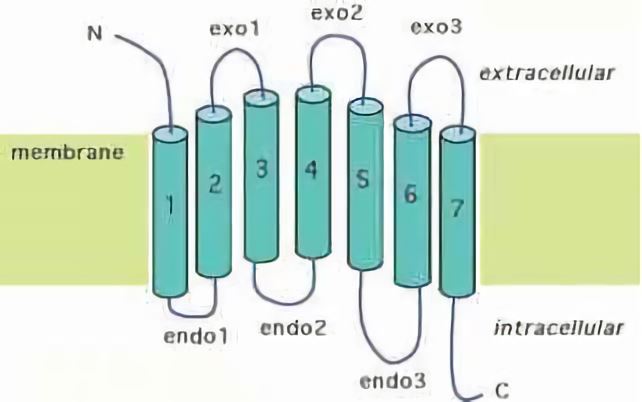Introduction of GPR34
Probable G-protein coupled receptor 34 is a protein encoded by the human GPR34 gene. It is a 7-transmembrane receptor that belongs to the G protein-coupled receptor family. Based on sequence similarities to the platelet-activating factor (PAF) receptor, the human GPR34 was already discovered in 1997 (AF039686.1) and found to be widely expressed in human and mouse tissues.
| Basic Information of GPR34 | |
| Protein Name | Putative G-protein coupled receptor GPR34 |
| Gene Name | GPR34 |
| Aliases | N/A |
| Organism | Homo sapiens (Human) |
| UniProt ID | Q9UPC5 |
| Transmembrane Times | 7 |
| Length (aa) | 381 |
| Sequence | MRSHTITMTTTSVSSWPYSSHRMRFITNHSDQPPQNFSATPNVTTCPMDEKLLSTVLTTSYSVIFIVGLVGNIIALYVFLGIHRKRNSIQIYLLNVAIADLLLIFCLPFRIMYHINQNKWTLGVILCKVVGTLFYMNMYISIILLGFISLDRYIKINRSIQQRKAITTKQSIYVCCIVWMLALGGFLTMIILTLKKGGHNSTMCFHYRDKHNAKGEAIFNFILVVMFWLIFLLIILSYIKIGKNLLRISKRRSKFPNSGKYATTARNSFIVLIIFTICFVPYHAFRFIYISSQLNVSSCYWKEIVHKTNEIMLVLSSFNSCLDPVMYFLMSSNIRKIMCQLLFRRFQGEPSRSESTSEFKPGYSLHDTSVAVKIQSSSKST |
Function of GPR34 Membrane Protein
G protein-coupled receptors (GPR) is one of the largest gene families whose primary function is to transmit extracellular stimuli such as light, hormones, neurotransmitters, peptides, and nucleotides, into intracellular signals via interaction of their intracellular domains with heterotrimeric G proteins. As a member of the GPR family, GPR34 was confirmed as a lysophosphatidylserine receptor in 2012. Originally, GPR34 was isolated from a human fetal brain cDNA library in 1999. The expression of GPR34 has been determined in different human tissues. Besides, it has been reported that GPR34 is highly expressed in several solid tumors, such as metastatic melanoma and MALT lymphoma. And it has an essential role in tumor development and progression. Studies have suggested that increased expression of GPR34 in the membrane of gastric cancer tissues was likely associated with metastatic ability, as well as invasion of NCI-N87 gastric cancer cells. What’s more, GPR34 could mediate signals to the interior of the cell via activation of heterotrimeric G proteins which in turn activate various effector proteins, ultimately resulting in a physiologic response.
 Fig.1 Structure of an archetypal GPCR.
Fig.1 Structure of an archetypal GPCR.
Application of GPR34 Membrane Protein in Literature
This article summarizes the current knowledge of GPR34 on its evolution, genomic and structural organization, physiology, pharmacology and relevance in human diseases including neurodegenerative diseases and cancer, which accumulated over the last 20 years.
This article focuses on the molecular basis of the structure-activity relationship of ligands of GPR34. It indicates that a kink in the benzene-based lipid surrogates matches the L-shaped hydrophobic pocket of GPR34. A tetrabenazine-based lipid analog bearing a bulky tert-butyl group at the 4-position of the terminal benzene ring exhibited potent GPR34 agonistic activity, validating the present hydrophobic binding pocket model.
The research is conducted to determine if GPR34 mRNA in granulosa cell [GC] changes during selection and growth of dominant follicles in cattle as well as to investigate the hormonal regulation of GPR34 mRNA in bovine GC in vitro. It comes to a conclusion that GPR34 is a developmentally and hormonally regulated gene in GC, and its presumed ligands enhance IGF1-induced proliferation and steroidogenesis of bovine GC.
This article investigates the process of membrane topology determination and how it relates to the acquisition of cell surface trafficking competence in human GPR34. It has shown that the underlying biochemical properties of the conformational epitope were, therefore, the key to understanding mechanistic processes propelled by positive-inside rule that simultaneously regulate the topogenesis and intracellular trafficking of GPR34.
This report reveals a novel role of GPR34 in the fate of DCs and identifies a regulatory mechanism that could be relevant for the treatment of GPR34-overexpressing pathologies, such as neuroinflammatory or cancer conditions.
GPR34 Preparation Options
To provide professional membrane protein preparation service for worldwide customers, we have successfully established advanced Magic™ membrane protein production platform. Our professional scientists will do their best to help you choose the most suitable program design for your particular project. Aided by our versatile Magic™ anti-membrane protein antibody discovery platform, we also provide customized anti-GPR34 antibody development services.
Creative Biolabs is dedicated to delivering the most satisfactory membrane protein related services/products for our worldwide clients. Our highly professional scientists are confident to make your project a success. In addition to GPR34 membrane protein products, we also provide other membrane protein preparation services to meet every client’s requirements. For more information, please feel free to contact us.
All listed services and products are For Research Use Only. Do Not use in any diagnostic or therapeutic applications.